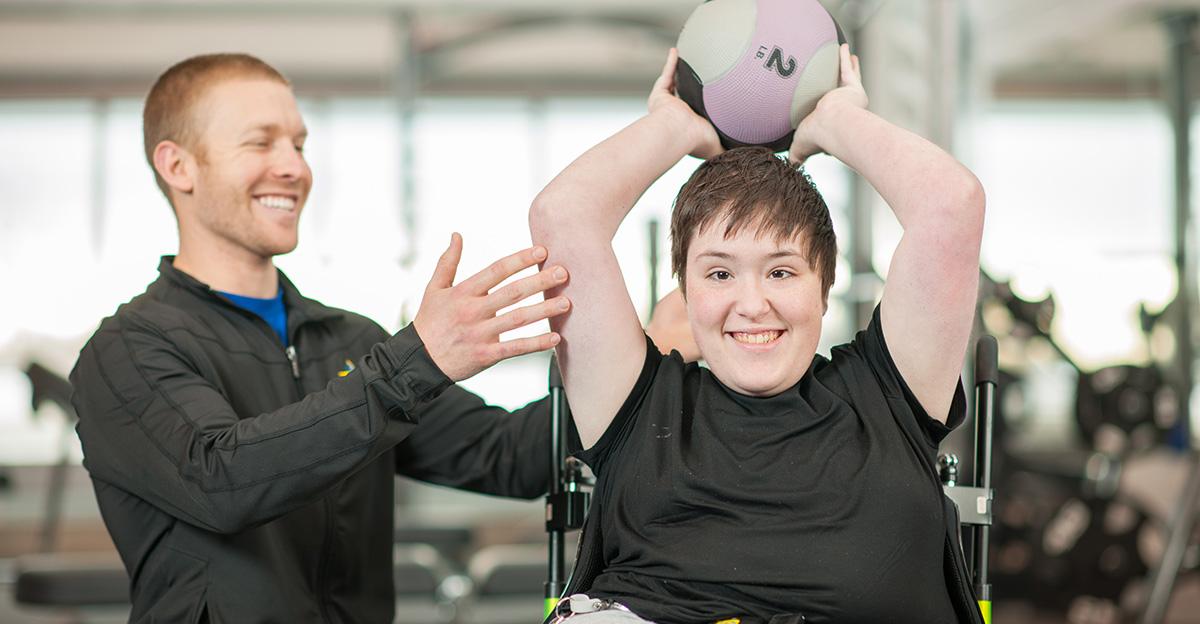We all need it… exercise! We even know why. Heart, digestive, respiratory, muscular, skeletal and mental health are all at risk without it and improves with regular workouts and exercise. But exercise can have emotional, social and spiritual benefits beyond the physical.
Exercise should include aerobics to get our heart and respiratory rate up for a period of time, balance challenges to challenge our muscles and minds, weight bearing activities to support strong bones, and coordination to stimulate eye-hand activities that are necessary for play and daily work.
For individuals with special needs, and particularly those with limited physical abilities or specific sensory needs, working out can be challenging. How do you include a special needs individual? If we open our hearts and minds and sprinkle our ideas with a bit of creativity, we can all reap the benefits of including those with unique physical, sensory and even learning needs into our physical education and daily exercise programs.
Keep in mind the following before planning:
- A workout should be challenging—it needs to push past a comfort zone
- It should be mentally motivating, requiring thinking and a brain-body connection
- It should be engaging—boredom can kill a workout before you start
- It helps if it can be social, as working out with friends is more impactful
- What is your sensory type?
- Sensory Seekers will respond well to props and heavy, stimulating activities like biking, jumping, climbing and dancing
- Sensory Under Responders will need props and music to keep them alert as well as variety and a motivator leader or coach
- Sensory Over Responders may enjoy a soothing workout like yoga, tai chi, walking or swimming.
Lets take a look as some different workouts for individuals with neurological, physical or sensory challenges.
Wheelchair Workouts
If you have an individual with physical limitations who uses a wheelchair to get around, there is no reason they cannot workout in their wheelchair. Starting with a couple pounds of weight (if able), you can start with upper body exercises that focus on the neck, shoulders, upper trunk, arms, and core. You can add in music and change around the equipment, too. Try repetitions of 20 (three sets of 20), but if that is too much you can do three sets of 10 or a set of 10, then 8, and then 5.
Sing Along Workouts
Adding music to a workout helps a lot. With younger children you can sing songs like Row Row Row your boat while working on rowing activities. Or Head Shoulders Knees and Toes while reaching for those parts of the body. With older kids, you can pick their favorite dance music. Singing along can help with respiration, verbalization, speech and language, communication and cooperation.
Animal Workouts
This is a favorite to get less motivated kids to move! Choose 10 animals and act like that animal. A crawling worm is great for upper body and core work. A chicken requires a lot of thigh work and arm work (clucking). A flamingo has to balance on one leg. A bear has to cross the river on all fours to go get his salmon, and of course there is the famous yoga position—Downward Facing Dog—which will stretch the hamstrings while strengthen the core, shoulders, and arms.
Partner Workouts
If you have a child who is challenged in some way, partnering them up with a friend can help. Look for someone who is kind and understanding, patient and selfless who will help their friend through moves, positions, games and exercise. Both individuals can check up on one another and motivate each other to work out. You can work on sports skills, exercise, cardio, weight lifting, or coordination skills with a partner.
Level the Playing Field
If you have children who are deaf or blind, you can level the playing field by adding earplugs or blindfolds so that everyone is with the same ability. This can create long-term empathy and fun! Kids will come up with multiple ways to engage and play games. Try having everyone sit on the floor for a game of blind handball. Grab a beeper ball and you can play using your sense of hearing only. Want to know what it’s like to not be able to use one arm? Wrap the other one up and play a game of volleyball.
Dance it Off
Dancing can be a great workout for individuals of all abilities. Grab your favorite music, props, and Zumba or dance away. This is a great workout for those in wheelchairs, sensory seekers, and those with ADHD. Dance can be adapted and can get your heart rate up and challenges focus, coordination, and attention. You can add in props like rainbow hoops, resistance bands, dumbbell weights, and exercise balls to your workout to add more resistance and provide a great outlet for differing sensory and physical needs.
Remember that being fit is not a destination. It’s a way of life for every individual because the JOURNEY is the destination.
Cecilia Cruse
Cecilia Cruse, MS, OTR/L has a BS degree in Occupational Therapy from the University of Florida, and her Master’s degree in Education from Georgia State University. She is SIPT certified and has over 25 years of experience in pediatrics with school-based services, acute care, and outpatient pediatric settings.







Leave a Reply